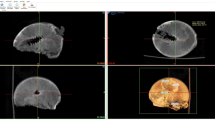Summary
With the advancement of computer technology it has been possible to determine stress distribution in bone by the finite-element method (FEM), for a pathomechanical analysis of aseptic necrosis of the femoral head. Development of aseptic necrosis of the femoral head has been considered to be coincident with ischemic changes in the bone. However, the area of necrosis in the femoral head does not correspond to vascular distribution. We speculated that not only biological, but also biomechanical factors might play an important role in the development of femoral head necrosis. A two-dimensional finite-element model, with 801 elements and 454 nodes, was constructed to mimic the hip joint. Conditions for the disease were simulated on the assumption that concentrated areas of high stress cause changes in the biomechanical properties of bone, according to Wolff's law, such as necrosis or sclerosis. Results of the simulation correlated well with clinical findings. Biomechanical factors should be considered, not only to prevent the collapse of bone structure but also to limit the spread of bone necrosis in the early phase of the disease.
Zusammenfassung
Mit dem Fortschritt der Computertechnologie ist es möglich geworden, Knochenstressverteilung durch die begrenzte Elementmethode zu bestimmen für eine pathomechanische Analyse der aseptischen Oberschenkelkopfnekrose. Es wurde bisher angenommen, daß die Entwicklung einer aseptischen Oberschenkelkopfnekrose mit einer ischämischen Knochenalteration zusammentreffe. Die Nekrosenzone im Oberschenkelkopf entspricht jedoch nicht seiner Gefäßverteilung. Wir sind davon ausgegangen, daß nicht nur biologische, sondern auch biomechanische Faktoren bei der Entwicklung der Oberschenkelkopfnekrose eine wichtige Rolle spielen könnten. Ein zweidimensionales begrenztes Elementmodell, mit 801 Elementen und 454 Knoten, wurde dem Hüftgelenk nachgebaut. In der Annahme, daß mit starken Stressen konzentriert belastete Bereiche nach Wolffs Gesetz biologische Knochenalterationen wie z. B. Nekrose oder Sklerose verursachen, wurden Krankheitsbedingungen nachgebildet. Die Ergebnisse dieser Nachahmung entsprechen sehr gut den klinischen Befunden. Nicht nur um den Kollaps im Knochenbau zu verhindern, sondern auch um die Verbreitung von Knochennekrose in der frühen Phase der Krankheit zu begrenzen, sollen biomechanische Faktoren berücksichtigt werden.
Similar content being viewed by others
References
Fisher D E, Bickel W H, Holley K E (1969) Histologic demonstration of fat emboli in aseptic necrosis associated with hypercortisonism. Mayo Clinic Proc 44:252–259
Inmann V T (1947) Functional aspects of the abductor muscles of the hip. J Bone Joint Surg 29:607–617
Lewis J L, Askew M J, Jaycox D P (1982) A comparative evaluation of tibial component designs of total knee prostheses. J Bone Joint Surg [Am] 64:129–135
Ninomiya S, Tagawa H, Miyanaga Y, Seki N (1975) The relationship between the position of the artificial hip joint and the resultant force acting on the femoral head. J Jpn Orthop Ass 50:15–20 (in Japanese with English summary)
Steinberg M E (1973) Avascular necrosis of the femoral head. In: Tronzo R G (ed) Surgery of the hip joint. Lea Febiger, Philadelphia, pp 428–449
Solomon L (1973) Drug-induced arthropathy and necrosis of the femoral head. J Bone Joint Surg [Br] 55:246–261
Tateishi T, Miyanaga Y (1978) Collection of data on biomechanics in the orthopaedic field. Asahi Science Co, Osaka, pp 93–152 (in Japanese)
von Mises R (1913) Mechanik der festen Kbrper im plastisch deformablen Zustand. Göttinger Nachrichten, Math-Phys Klasse, pp 582–592
Wertheimer L G, Lopes S D L F (1971) Arterial supply of the femoral head. J Bone Joint Surg [Am] 53:545–556
Author information
Authors and Affiliations
Rights and permissions
About this article
Cite this article
Ueo, T., Tsutsumi, S., Yamamuro, T. et al. Biomechanical aspects of the development of aseptic necrosis of the femoral head. Arch. Orth. Traum. Surg. 104, 145–149 (1985). https://doi.org/10.1007/BF00454690
Received:
Issue Date:
DOI: https://doi.org/10.1007/BF00454690




